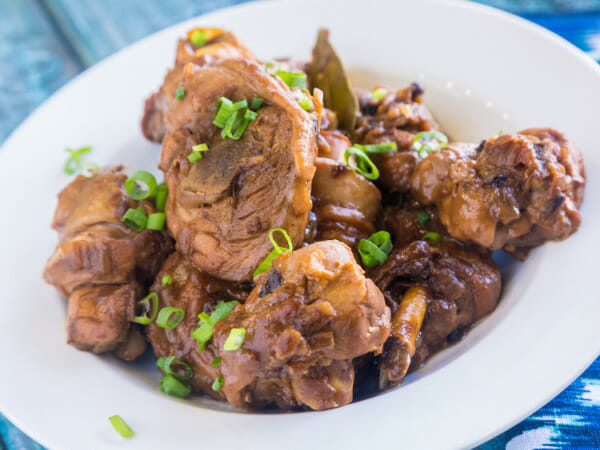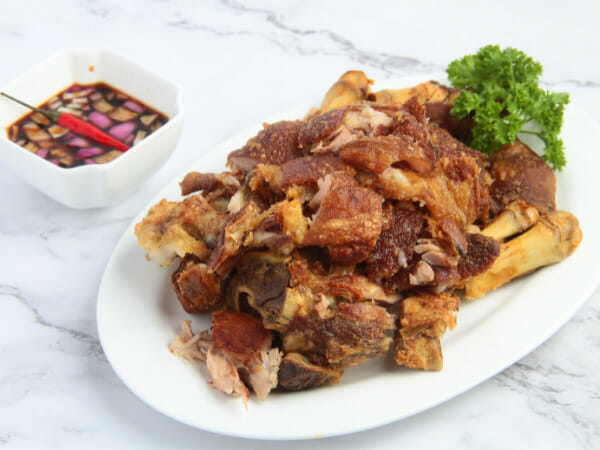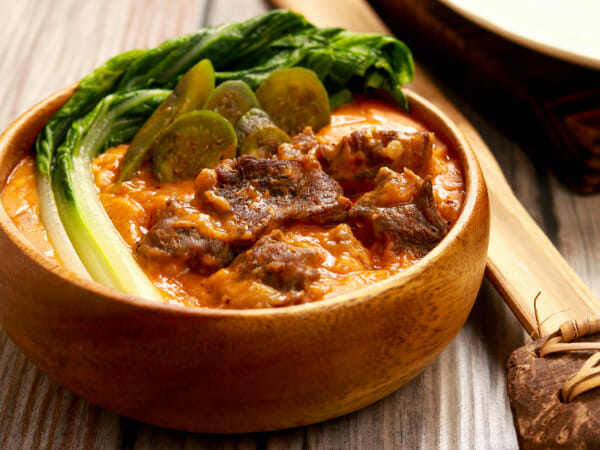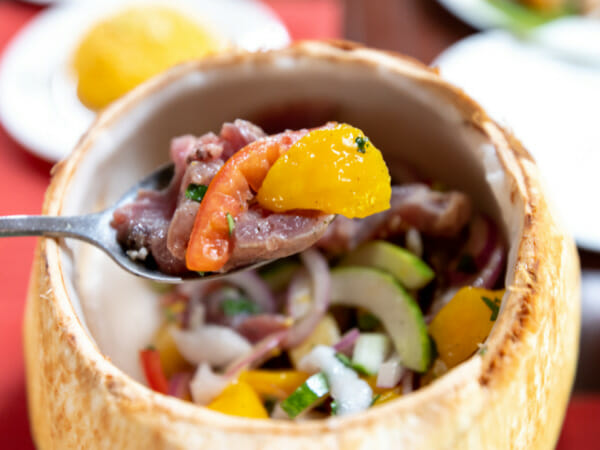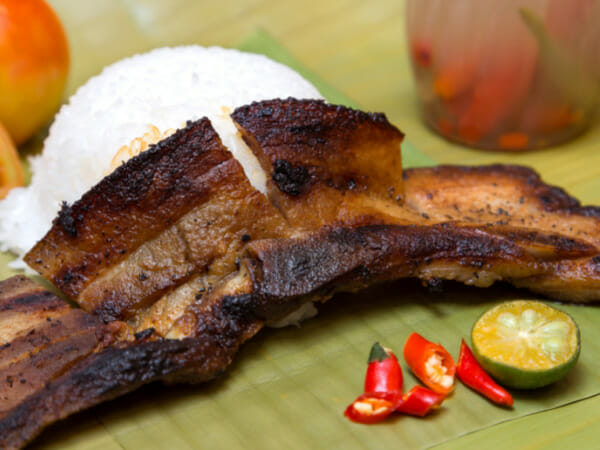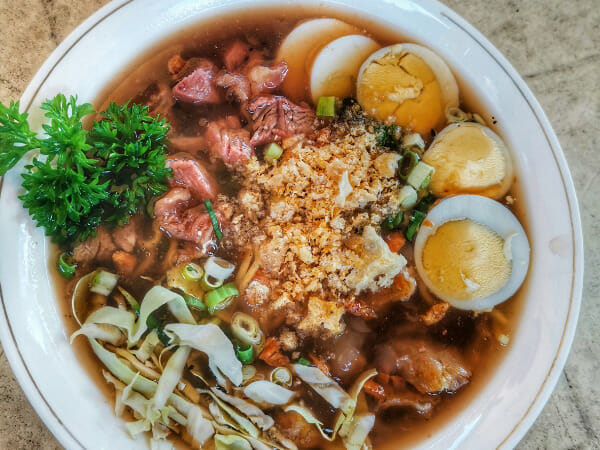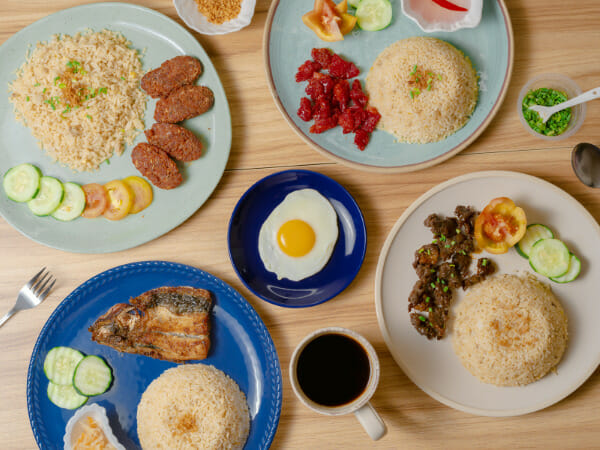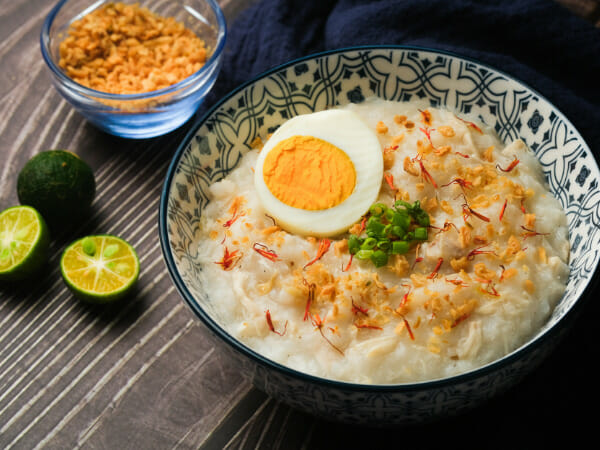The Best Filipino Food to Try When Visiting the Philippines
Visiting the Philippines is an exciting experience. Like hitting two birds with one stone, soak in the beauty of its scenic attractions and relish the extensive food selection. Trying different types of Filipino foods isn’t just a handful. It is a mouthful and a delightful gustatory adventure in itself. To guide you in your search for top dishes that are unique, authentic, sweet, spicy, savory, and crispy,
Famous Filipino food to try that is hungry-worthy
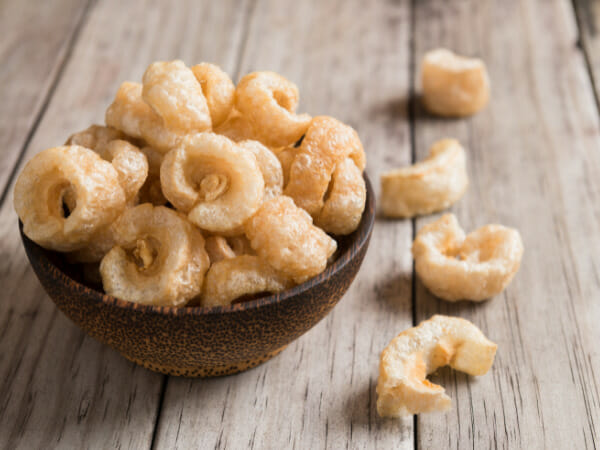
1. Chicharon (Deep-Fried Pork Rinds)
Take a bite into one of the most popular Filipino appetizers called Chicharon. Spanish in origin, this is the Filipino version of Chicharrones. Chicharon is a deep-fried appetizer.
They are commonly used as chicharon is the pork rind. Another popular type of chicharon is Chicharon Bulaklak. (intestinal membrane). Deep-fried chicken skin is another form of chicharon that is crunchy and yummy.
How to prepare this food?
The pork rind or intestinal membrane is boiled, seasoned, and deep-fried. You can easily buy chicharon at stores and restaurants. Dip your chicharon in a spicy vinegar sauce and enjoy the crunch over a bottle of beer.
2. Balut (Boiled Duck Embryo)
Sampling Balut or duck embryo will bring out the adventurer in you! Eating this delicacy will give you a unique experience that you can flex to family and friends back home.
How to prepare this food?
To make Balut, you need duck eggs. Duck eggs are fertilized and incubated for several weeks. Once done with the process, these eggs are boiled and served.
How to eat it? Like eating a hard-boiled egg, crack it and peel off the shell. You may season it with salt and take a quick slurp of the duck embryo liquid and then eat the duck insides.
Some restaurants serve this delicacy by sautéing it with spices, served with vegetables in season. Nothing beats the experience of eating it straight from its shell. Give it a try!
3. Adobo
When in the Philippines, Adobo is a must-try for everyone, meat lovers and vegetarians alike. Adobo is a traditional Filipino dish that has found a spot in Filipino homes. It is considered the national dish in the Philippines and is known globally.
Its origin is debatable, though pointing to a Spanish influence. But one thing is for you. Hands down, you will fall in love with Adobo.
How to prepare this food?
The cooking process is simple. A lot of restaurant chefs have added their special touches to this dish. Marinade the meat (pork, chicken, or beef) in garlic, black pepper, soy sauce, and vinegar. Bayleaf is added. Let it simmer until tender and when the thicker sauce has been formed. Several home cooks add coconut milk and brown sugar to the Adobo for a slightly sweet and creamier taste.
There is also a vegetable version of the Adobo. You can use Kangkong (water spinach) or okra. Best enjoy Adobo is with steamed rice with a side dish of tomatoes or pickled papaya (atchara)
4. Lechon (Roasted Pig)
Having Lechon is the heart of a Filipino fiesta or party. Lechon is the country’s national pride, one of the top Filipino dishes served at celebrations and special occasions.
How to prepare this food?
An entire suckling pig is roasted while being turned on a spit. Before spit-roasting, the pig is marinated and stuffed with peppers, spring onions, garlic, different spices, and lemongrass.
The meat is flavorful and tender, while its skin has turned into the crispy golden brown that many people like. Others prefer a younger pig to be spit-roasted called Lechon de Leche.
You can eat Lechon with rice or eat it as an appetizer. Its dipping sauce, called Lechon sarsa (sauce), is a liver sauce fused with vinegar, garlic, black pepper, and breadcrumbs.
A chicken version of the Lechon is called Lechon Manok (grilled chicken). A whole chicken is marinated with spices and spit-roasted until done.
5. Crispy Pata
Crispy Pata is one of the most popular and well-loved Filipino dishes around. This crispy and tender pork knuckle is a staple in many Filipino celebrations, big or small.
How to prepare this food?
Cook the pork knuckle with black pepper, salt, and other spices until tender and then deep-fried until golden brown. Crispy Pata meat remains tender while the skin is golden crispy.
Enjoy the crunchy skin and tender meat of the Crispy Pata over freshly cooked rice. A dipping mixture of soy sauce and vinegar is a good match.
6. Sinigang na Baboy (Pork cooked in Tamarind Broth)
Sinigang na Baboy is a famous Filipino food that is an absolute must-try for anyone visiting the Philippines. One of the top Filipino recipes, Sinigang, is a Sunday meal where most Filipino families gather and eat together.
This soup is uniquely different from other Asian-inspired dishes in its distinct sourness. The tamarind flavoring adds a tangy taste making this dish more enjoyable.
How to prepare this food?
Boil your choice of pork, beef, or chicken together with crushed tomatoes and peeled onions until tender. Separately, boil tamarinds put in a filter, and crush until you get a tamarind base. Add the tamarind base to the boiled meat with green chilies and vegetables such as sliced radish, beans, okra, eggplant, and kangkong (water spinach). Add fish sauce to taste. For those who want a non-meat dish, substitute with fish.
Eating Sinigang na Baboy becomes more enjoyable with a bowl of freshly-cooked rice. A lot of Filipino households serve Sinigang with Adobo on the side. Try it!
7. Kare-Kare (Oxtail in Peanut Sauce Stew)
Kare-Kare has been beautifully influenced by a curry dish called “Kari-Kaari,” created by Indian chefs. This tasty dish is curry-inspired. Instead of using spicy curries, peanut sauce is the main star of this delicious dish.
How to prepare this food?
The traditional way of preparing Kare-Kare is by using oxtail and pork trotters. Clean and boil these meat cuts with delicious peanut sauce until tender. Add vegetables like cut-up banana blossoms, beans, sliced eggplants, and water spinach to the peanut sauce and season with fish sauce. For a creamier Kare-Kare, some chefs add coconut milk. You can substitute oxtail with beef, pork cuts, chicken, or goat meat.
Though goat meat stewed in tomato sauce, liver, bell peppers, olives, and potatoes make Caldereta, another classic Filipino dish, perfect as an appetizer.
Vegetarians will be thrilled to know that there is a meatless but flavorful version. Simply add vegetables to the peanut sauce and let it simmer until done.
Enjoy this Filipino stew with mounds of rice like most locals do. Eat it together with bagoong or shrimp sauce. The salty bagoong balances out the rich flavor of the Kare-Kare.
8. Kinilaw (Filipino Ceviche)
Kinilaw is a Filipino type of Ceviche. Popular in many countries, Ceviche features raw fish cured in a vinegar and citrus juice mix.
Kinilaw does the same thing. Fresh tuna, salmon, Bangus (milkfish), or shellfish are often used and cured in the Filipino-style vinegar mix.
How to prepare this food?
Usually, tuna and mackerel are the fish choices for this dish. Cut fish into bite-size pieces. Cure the fish in a vinegar mix with calamansi (Philippine lime), sliced onions, garlic, green chilies, salt, and black pepper.
While enjoying the beautiful beach at dusk, have a bite of Kinilaw with your favorite drink.
9. Kilawin
Don’t be confused with the spelling. Kilawin is the meat version of the Kinilaw. Sometimes, goat meat is used. Strips of goat meat are marinated in a vinegar mix and cooked. You heard it right. This meat dish could be grilled or pan-fried.
How to prepare this food?
Cut up strips of meat and marinade in vinegar, calamansi (Philippine lime), black pepper, salt, and chilies.
10. Bulalo
Feast your eyes on a traditional Filipino cuisine called Bulalo, originating from the province of Batangas. Among Filipino dishes around, Bulalo is the only slow-cooked soup dish that uses beef shanks and bone marrow as its prime ingredients. Traditionally, Bulalo is slow-cooked on a wood-burning stove.
How to prepare this food?
Bulalo is slow cooking at its finest. Boil the beef shanks and bone marrow with onions and spices until tender. Add vegetables like string beans, cabbage, and potatoes. Eat this satisfying food with rice.
11. Bicol Express (Spicy Pork Stew)
While typical Filipino cuisine is not famous for spiciness, unlike Asian neighbors India, Indonesia, and Malaysia, there is an exception to the rule with Bicol Express. Add Bicol Express to spice your taste buds.
Bicol Express is a savory stew from the Bicol region of the Philippines. In Bicol, this dish is popular as “sinilihan.”
Where did the dish get its name? Interestingly, this delicacy was named “Bicol Express” by Cely Kalaw, a Filipino resident who joined a Manila-based cooking competition in the 70s. She was inspired by the train route between Manila and Legaspi (Bicol).
This creamy Filipino stew in coconut milk with spicy chilies and shrimp paste is the crowning glory.
How to prepare this food?
Cut the pork belly into small strips and sautée with onions and garlic. Add chili peppers and coconut milk once the meat is brown, and let it simmer. If you prefer it spicier, add more chilis. Add shrimp paste for extra flavoring.
Other versions of Bicol Express substitute meat with fish, seafood, and even vegetables. The meal preparation is the same.
Freshly steamed rice goes very well with Bicol Express. You may also sample it as a spicy appetizer. Others prefer to test it as an appetizer with their favorite alcoholic drink.
12. Chicken Inasal
This Filipino grilled chicken dish should be in the number spot for chicken lovers! This dish is grilled, and juicy heaven sent from Bacolod, where it originated.
How to prepare this food?
To cook Chicken Inasal, marinate chicken in a Bacolod-style mix of calamansi (Philippine lime), black pepper, garlic cloves, vinegar, and annatto. While grilling the chicken, continue to baste it to seal the taste further. The grill will give its golden brown color.
Eat your chicken Inasal over a bed of garlic rice drenched with chicken oil. A side dish of atchara (pickled shreds of papaya) is perfect.
13. Inihaw Na Liempo (Grilled Pork Belly)
This one is a sure winner on the taste buds of pork belly lovers. Inihaw na Liempo is Filipino-style grilled pork belly and one of the most popular Filipino dishes in any Pinoy home.
How to prepare this food?
Preparing this delicious Filipino food is easy. Marinade pork belly in vinegar, black pepper, garlic, soy sauce, and chilis for several hours. Grill until brown.
Eating Inihaw na Liempo goes very well in a soy sauce and vinegar dipping sauce or simply crushed tomatoes. You will love eating rice with this delicious pork belly dish.
14. Inihaw na Bangus (Grilled Milkfish)
You will adore feasting on Inihaw na Bangus (Grilled Milkfish). Bangus, locally known as milkfish, is the national dish of the Philippines. Dagupan, a Philippines province, takes pride in having the newest catch of freshwater Bangus in that area.
You can cook this particular fish in several ways. Its milky white meat and pleasing taste are perfect for grilling. Grilling it is a must-try!
How to prepare this food?
Stuff the Bangus with chopped onions, garlic, tomatoes, ginger, salt, and black pepper. Grill the fish until done.
Enjoy your Inihaw na Bangus with a dipping sauce of vinegar, soy sauce, and calamansi (Philippine lime). Don’t forget to eat with a bowl of freshly-cooked rice.
Bangus is also prepared as a smoked fish. Fry the smoked bangus and eat with a spicy vinegar sauce.
15. La Paz Batchoy(Noodle Soup)
Try a bowl of steamy and savory La Batchoy noodle soup. The dish points to its origin in La Paz, Iloilo.
This noodle soup dish is quite popular and served in many restaurants.
How to prepare this food?
Cook the egg noodles in a pork and beef broth. Add bits of pork, chopped pork liver, and some vegetables mixed with a raw egg to the noodles and serve it with toasted garlic.
A version of the La Paz Batchoy was created called Batchoy Tagalog. Instead of egg noodles, cook misua noodles (thin and stringy noodles) in a ginger-based pork broth. Add the pork bits.
Many guests enjoy La Paz Batchoy as either a breakfast entry or a late afternoon snack.
16. Dinuguan (Pork blood stew)
Filipino dishes are popular to be savory, just like Dinuguan. Dinuguan is a unique, deep chocolate-colored tasty dish made from pork offal and pork bits cooked in a blood and vinegar mix. Dinuguan comes from the Filipino word ‘dugo,’ meaning blood.
How to prepare this food?
Simmer the pork belly strips and pork offal in a vinegar mix, garlic, black pepper, salt, ginger, green chili, and fish sauce. Once the mixed meats are tender, add blood and sugar. Simmer for several minutes and serve. When eaten as an afternoon snack, Puto (rice cakes) go well with Dinuguan.
17. Silog (Fried Rice)
Silog is a combined word: Sinangag (garlic fried rice) and itlog (fried egg). With this fried rice and egg dish, you can add a favorite meat or fish dish such as Tapa (Tapsilog), Corned Beef (Cornsilog), Longganisa or Filipino sausage (Longsilog), Hotdog (Hotsilog), Fried Bangus or Milkfish (Bangsilog), Tinapasilog (Smoked fish).
How to prepare this food?
To cook garlic fried rice, simply saute garlic and rice together and season with salt. Prepare the meat or fish dish and eggs by frying until done.
Longganisa is a Filipino sausage. Just fry the sausage.
Preparing Tapa is easy. Marinate the sliced beef meat in vinegar, soy sauce, garlic, and black pepper. After a few minutes of marinating, fry the meat and add it to the garlic rice. Enjoy your complete and filling Silog meal with your vinegar-based dipping sauce or atchara (pickled green papaya).
18. Pork Sisig
Pork Sisig is one popular Filipino food you should try! Pig head and liver are the primary ingredients in this savory dish originating from Pampanga province.
How to prepare this food?
Chop the pig head and liver finely. Then marinate it in vinegar, lemon juice, salt, black pepper, and chili peppers. Simmer the meat mixture until brown. Serving Sisig on a sizzling plate adds to the drama.
Other versions of this dish use ground pork, finely chopped chicken, fish, or tofu, perfect for vegetarians.
Eat sisig with a bowl of rice. Sisig is an excellent appetizer for local beers or your favorite drink.
19. Arroz Caldo
Arroz Caldo is the Filipino variation of the Chinese congee. It is a filling Filipino rice porridge with bits of chicken enjoyed on rainy days. Arroz Caldo is a Spanish word for rice soup. It is also known as ‘Pospas’ in the Visayas area.
How to prepare this food?
Cook chicken pieces separately in a ginger-based broth. Shred the chicken meat and then set it aside. Boil glutinous rice and regular rice together. Stir in more water for the soup base. Add the shredded chicken and season with pepper and fish sauce. You may also add a bit of kasubha (sunflower) to give the dish a yellowish color. Add scallions, toasted garlic, and crushed Chicharon as garnishings.
While it is popular comfort food on rainy days, you can also enjoy Arroz Caldo anytime. Add a bit of the dipping sauce of fish sauce and calamansi (Philippine lime) in between bites.
20. Pinakbet
Pinakbet or ‘pakbet’ will always be part of authentic Filipino cuisine. This Filipino food is a well-known savory meat and vegetable dish cooked with bagoong (fermented shrimp paste) originating from the Ilocos region.
How to prepare this food?
Before adding the vegetables, saute garlic, onions, strips of pork belly, and cut shrimps. Stir fry squash, green beans, okra, and sliced eggplant. Finish off with shrimp sauce to add more flavoring. Top the vegetables with a deep-fried pork belly. Eat with steamed rice.
21. Lumpia or the Filipino spring rolls
The Lumpia is the Filipino style of the centuries-old Chinese spring roll.
How to prepare this food?
Fill flour wrapper with finely-sliced bamboo shoots, carrots, sprouts, bits of chicken, pork, or shrimp. Once ready, coat the rolls with egg wash and then deep-fry them.
Either way, the Lumpia goes well with sweet and sour sauce or Filipino banana ketchup. Enjoy your Lumpia as a yummy snack or part or as a side dish of your main meal.
22. Pancit Guisado
This is the Filipino version of tasty stir fry noodles, tracing its roots to Chinese cooking. Pancit is derived from the Hokkien words ‘Pian e sit,’ meaning something cooked fast. Guisado means sauteing. Pancit is common in many restaurants.
How to prepare this food?
Soak the Bihon (a kind of rice noodle) in water to soften it. Sauté garlic, onion, pork strips, shrimps, chicken liver, sliced carrots, string beans, parsley, and the Bihon (rice noodles). Add soy sauce and black pepper for flavor. Others prefer to add oyster sauce. Add slices of hard-boiled eggs, strips of pork, and calamansi (Philippine lemon) as toppings.
23. Torta (Omelet)
Spanish in origin, Torta in the Filipino cuisine is an omelet. There are different Filipino ways to cook Torta. You can cook this with ground meat, diced potatoes and carrots, and raisins and make it into an omelet.
Tortang Alimasag (crab meat) has crab meat and eggs and was served in a crab shell.
How to prepare this food?
Beat 3 – 4 eggs and set aside. Saute onions, garlic, diced tomatoes, potatoes, bell peppers, carrots, and ground pork. You can also add a little tomato sauce for a richer taste. Cook until the ground pork is brown. Pour the meat and egg mixture into a heated pan and cook it like an omelet. Flip the other side until done. Serve with your banana ketchup.
Vegetarians will like Tortang Talong (eggplant). Grill the eggplant first and remove the outer skin. Mix the eggplant with beaten eggs and cook. You can eat this savory Torta any time of day.
24. Kakanin (Sticky Rice Cake)
Kakanin tops the list of Filipino delicacies commonly served as a snack time or dessert.
Sticky rice cake, a Filipino food, generally means glutinous rice cake and comes in different delightful forms. Glutinous rice paste is the main ingredient in making Kakanin.
Puto is a white rice cake. Puto Bumbong is a variation of the Puto. The Puto Bumbong is a purple sticky rice cake cooked in small bamboo tubes.
Another sticky rice cake is the Kutsinta, which is orange in color. This cake is more chewy and sticky than Puto.
Ginataan is a sweet porridge with glutinous rice, coconut milk, and sugar. It also has bits of corn or toasted mung bean.
Leche Flan (custard) is a top sweet snack at par with Kakanin.
How to prepare this food?
The standard way of cooking kakanin is through steaming. Once ready, you can serve this with grated coconut and cheese. You can cook Leche Flan through burning.
25. Pork Barbecue
Filipino Pork Barbecue is a popular Filipino street food that has made its mark in enormous celebrations. Pork barbecue hits the spot as a portion of enjoyable comfort food. You can find these pork skewers available in many restaurants around the country.
How to prepare this food?
What makes the Filipino barbecue distinct is its marinade. Soak pork bites in a mixture of soy sauce, vinegar, banana ketchup, black pepper, garlic, brown sugar, Sprite or 7-Up, and calamansi (Philippine lime). You may add some chilis for a spicy taste. Preferably, marinate the pork overnight. Put pork on skewers and grill, serve and enjoy.
26. Halo-Halo
A sweet ending to this must-try list is a delightful ice dessert – Halo-Halo. Halo-Halo locally means mixed and similar to a parfait and Korean Bingsu. This creamy dessert will satisfy every sweet tooth.
How to prepare this food?
Add kaong (sugar palm tree fruit similar to jelly beans), sweetened langka (jackfruit), sugar plum fruit, sweetened beans (red or mung bean, sago (tapioca), and sweetened plantains in a glass. Load the glass with crushed ice, evaporated milk, and top it with Ube (purple yam) and Leche Flan (custard). How pretty is that? Leche Flan (custard) is a well-loved sweet Filipino food that goes very well with a cup of coffee.
Conclusion
Eating is a joyful adventure. Enjoying authentic Filipino dishes adds to the country’s appeal. Go ahead, eat in the Philippines. Forget the diet. Indulge in the mouth-watering street food, the salty appetizer, and savory dishes to better understand and appreciate the locals’ culture and lifestyle. Undoubtedly, eating Filipino foods will make your stay in the country more memorable.

